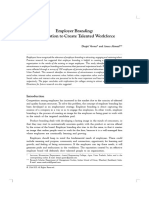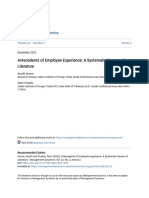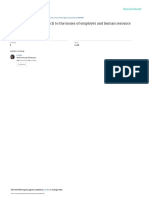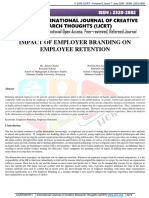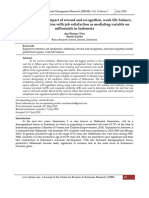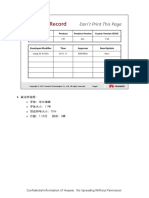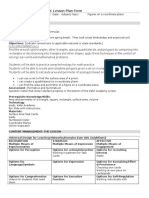Paper 2 Grupo 2
Paper 2 Grupo 2
Uploaded by
jaimeortega02Copyright:
Available Formats
Paper 2 Grupo 2
Paper 2 Grupo 2
Uploaded by
jaimeortega02Copyright
Available Formats
Share this document
Did you find this document useful?
Is this content inappropriate?
Copyright:
Available Formats
Paper 2 Grupo 2
Paper 2 Grupo 2
Uploaded by
jaimeortega02Copyright:
Available Formats
Florentina Cindy Finishtya
THE DIMENSION OF EMPLOYER BRANDING:
ATTRACTING TALENTED EMPLOYEES TO
LEVERAGE ORGANIZATIONAL COMPETITIVENESS
JAM Ambara Purusottama
17, 1 Ari Ardianto
Received, October 2018 School of Business and Economics, Universitas Prasetiya Mulya, Indonesia
Revised, January 2019
February 2019
Accepted, February 2019
Abstract: The challenge to meet the fulfillmentofthe workforce needs in Indonesia in the
near future makes organizations immediately improve and use employer branding as an
instrument of organizational competitiveness in “the war of talent”. This research invites us
to explore the dimensions of employer branding and also examines the dimensions towards
talented local employees (students) in Indonesia. Our findings, three of five dimensions of
employer branding namely working environment, company reputation, and corporate vi-
sion provide a positive and significant influence on the interest of talentedlocal employee’s
career. Therefore, compensation benefitsand corporate social responsibility as part ofthe
employer branding’s dimensions are not considered by talentedlocal employees in their
intention to join the organization despite having a positive relationship. These findings
provide insight into the importance of employer branding in maintaining the competitive-
ness of companies by focusing more on the intangible dimensions.
Keywords: Organization Competitiveness; Employer Branding Dimension; Talent Employee.
Cite this article as: Purusottama, Ambara and Ari Ardianto. 2019. The Dimension of Em-
ployer Branding: Attracting Talented Employees to Leverage Organizational Competi-
tiveness. Jurnal Aplikasi Manajemen, Volume 17, Number 1, Pages 118–126. Malang: Univer-
sitas Brawijaya. http://dx.doi.org/10.21776/ub.jam.2019.017.01.13
Companies in Indonesia are though the education fund has been raised by the
starting to address the issue government and has been ratified in the constitu-
of fulfilling the quantity and tion. In the future, 55% of jobs in Indonesia will be
Journal of Applied
Management (JAM) quality of talented local em- administrative or managerial, compared to the cur-
Volume 17 Number 1, ployees at every level in the rent 36%. Indonesia has not been able to produce
March 2019
Indexed in Google Scholar
organization. The Asian De- university graduates of excellent quality to fulfil the
velopment Bank (2016), pre- available position.
dicts the condition of Indone- Employer branding conceptually provides com-
sian human resources in less panies with a strategic thinking framework where
Corresponding Author: than a decade into the fu- there is a collaboration between marketing and hu-
Ambara Purusottama, School
of Business and Economics,
ture will still not be able to man resource management (Maxwell & Knox,
Universitas Prasetiya Mulya, meet the needs of entry-level 2009). Thus, the organization can attract, maintain,
Indonesia, E-mail:
ambara.purusottama@pmbs.ac.id, positions especially in large and also be able to contribute as a motivator for its
DOI: http://dx.doi.org/ companies, due to scarcity of employees. Brands also play a major role inselection,
10.21776/ub.jam. 2019.017.
01.13 good quality candidates even and strong employer branding will contribute to the
118 JOURNAL OF APPLIED MANAGEMENT 118VOLUME 17 NUMBER 1 MARCH 2019
The Dimension of Employer Branding: Attracting Talented Employees
development of good employee attitude(Berthon, talentedlocal employees towards their interest in
Ewing, and Hah, 2005). applying for jobs in the context of employer brand-
The current workforce challenge is how to ing.
obtainhigh-qualityand loyal workers. Therefore,
strong employer branding is increasingly becoming LITERATURE REVIEW
relevant intoday’s business. Companies that embrace Employer Branding
employer branding are companies that are well po-
Employer branding is a new idea that has been
sitioned to have a strong position in the competitive
tested by practitioners and academics in the fieldof
labor market (Cascio, 2014). In the past few
marketing. The term shows differences in the char-
years,studiesonemployer branding have not been
acteristics of the company as an employer from
widely carried outin Indonesia. In the previous
other competing companies. Employer branding
study,Amelia and Nasution (2016),provide insightinto
underlines the unique aspects of a company’s offer
the importance of employer branding in Indonesia
or environment (Backhaus & Tikoo, 2004). “Em-
particularly the war of talent inthe mining industry.
ployer Branding” as a concept borrowed from mar-
This study aims to explore and examine the
keting explains the level of attractiveness of an
impact of the perception of talented local employ-
employee and talentedlocal employees of the com-
ees on the five components of employer branding
pany. Employer branding helps organizationsfocus
which includes working environment, compensation
on how they can identify themselves in the market-
and benefits, corporate reputation, corporate vision
place as employersofemployees and
and leadership, and also corporate social and envi-
talentedemployees; for new recruitment as well as
ronmental responsibility towards theircareer inter-
suppliers or partners of customers (Lievens &
ests. Furthermore, this study also determines the
Slaughter, 2016).
individual factors that are considered important by
Table 1 The Dimension of Employer Branding
Employer Branding Dimension References
Working Environment Swider, Zimmerman, Charlier, and J.Pierotti (2015) and
Boamah and Laschinger (2016).
Compensation and Benefit Gilani and Cunningham (2017) andWidyaningsih (2016).
Corporate Reputation Biswas and Suar (2016) andJain and Bhatt (2015).
Corporate Vision and Leadership Wallace, Chernatony, and Buil (2013).
Corporate Social and Environmental Responsibility Biswas andSuar(2016) andJones, Wicks, and Freeman
(2017).
The main objective of the employer branding strategy. Employer branding places an image that
concept is to positively influence employees and shows the organization/company as “a good place
talentedlocal employees to attract high-quality em- to work”.
ployees (Saini, et al., 2013). The use of the prin- Many scholars stated that employer branding
ciples of branding in human resource management influences the success of the company to improve
is currently called “employer branding”. the quality and quantity of applicants. Many com-
Theincreasing use of employer branding concept by panies have developed formal employer branding
companies is to attract attention and ensure that all or interest in developing the program (Botha, et al.,
employees participate in the company’s culture and 2011). Since the company operates its operations in
DIKTI ACCREDITED SK NO. 30/E/KPT/2018 ISSN: 1693-5241 119
Florentina Cindy Finishtya
a strong global competition, strong employer brand- Individuals will feel proud if they work and have
ing has become a crucial solution to improve excel- benefits which are in linewith their expectations.
lence in “the war of talent”. Strictly speaking,Gilani and Cunningham (2017) ex-
plain that individuals will feel more valued and have
Employer Branding in Indonesia a better attachment with the organization if they get
Employer branding in Indonesia has been initi- a better salary and other appropriate compensation.
ated by several large companies to obtain the re- Widyaningsih (2016),stated that other compensation
quired organizational assets. In the future, the role obtained includes health insurance, pensions, and
of employer branding will be increasingly crucial incentives in the form of bonuses. Therefore, the
given the increasingly scarce quality workforce and hypothesis that can be built is:
the limitations of the talented pool. Employer brand- H2: There is a positive and significant relationship
ing strategies are becoming important with the in- between the perception of talented employees
creasingly fierce industrial competition in Indone- of compensation and benefits towards the in-
sia, particularly in several industries that require tention to apply for a job.
specific quality workforce such as in the banking
and mining sector. Corporatereputation has a significant influence
A study fromKusuma and Prasetya (2017), on the company’s talented employees (Biswas &
found that PT Bank Central Asia Tbk (BCA) real- Suar, 2016). Biswar and Suar also argue employee
ized the importance of employer branding and will feel proud to be able to join a company with a
formed an employee value proposition to create high- good image or reputation. Jain and Bhatt (2015),in
quality employee engagement. In other sectors such their study found that for career choices in compa-
as mining,Amelia and Nasution(2016), emphasize nies, individuals will consider several interests that
the importance of employer branding in the face of have a positive impact on themselves, among oth-
competition for prospective employees. Both of them ers, the reputation and stability of the company, work
agree that employer branding has an important role balance, and job security.
in increasing organizational competition through H3: There is a positive and significant relationship
employer branding. between the perceptions of talented employ-
ees of corporate reputation towards the inten-
RESEARCH FRAMEWORK AND HYPOTH- tion to apply for a job.
ESIS
According toWallace, et al. (2013), leadership
The dimensions of the working environment are
in an organization will determine the commitment
relevant in the discussion of employer branding, see
of its workers. In other words, a leader is key to
Table 1. Swider, et al., (2015),revealed the impor-
running an organization effectively(Biswas & Suar,
tance of working environment factors as a major
2016). In the midst of competitive organizations to-
factor in accepting job offers. Boamahand
day. It will be easier to lose employees because of-
Laschinger(2016), also emphasized the importance
fers are better from elsewhere. Thus, it is not just
of the working environment as an instrument to re-
about job security and compensation that is impor-
tain employees and also encourage employee in-
tant but also career potential and self-development.
volvement in the organization. Thus,the hypothesis
H4: There is a positive and significant relationship
is:
between the perception of talented employees
H1: There is a positive and significant relationship
of corporate vision and leadership towards the
between the perceptions of talentedlocal em-
intention to apply for a job.
ployees regardingthe working environment to-
wards the intention to apply for a job.
120 JOURNAL OF APPLIED MANAGEMENT VOLUME 17 NUMBER 1 MARCH 2019
The Dimension of Employer Branding: Attracting Talented Employees
Perceptions of Work H1
Environment(CWE)
Perceptions of Compensation H2
and Benefits (CCB)
Perception of Corporate Intentiontoapply for a job
H3
Reputation(CCR) (ITA)
Perception of Corporate Vision
H4
&Leadership(CVL)
Perception of Corporate Social &
Responsibility (CSR) H5
Figure 1 Research Framework and Hypothesis
Jones, et al. (2017),shows that there is a link ees, who are students in Jakarta and Tangerang,
between CSR companies’CSR programs and strong Indonesia. This research is aimed more t at stu-
employer branding. CSR in practice can change the dents majoring in management and accounting be-
company’s image and become a measure of for cause these students are more likely to have a ca-
employees and talented employees in their career reer in managerial positions. The surveysucceededin
choices. The better the CSR owned by the compa- collecting 277 respondents based onpredetermined
nies, the better it will further increase the desire of goals. The statements given by the respondents
talented employees towards the company as their weremeasured using a Likert scale from 1 “Strongly
career choice in the future. Disagree” to 5 “Strongly Agree” because the Lickert
H5:There is a positive and significant relationship scale has better quality results than other scales
between the perception of talented employees (Revilla, et al., 2013).The data analysis used Struc-
of corporate social and environmental respon- tural Equation Model (SEM) to show the relation-
sibility towards the intention to apply for a job. ship between variables with AMOS software ver-
sion 24.
METHOD
Direct surveys are conducted using a purpo-
sive sampling approach for talentedlocal employ-
DIKTI ACCREDITED SK NO. 30/E/KPT/2018 ISSN: 1693-5241 121
Florentina Cindy Finishtya
Table 3 Research Instrument
Code Observed Variable References
CWE_2 My working environment should encourage employee creativityA dynamic work- (Hur, 2012)
CWE_3 ing environment will be my choice as a place to work
CCB_3 Compensation in the form of health and life insurance is my priority (Hur, 2012)
CCB_4 Retirement benefits are a factor to be considered
CCB_5 Further study is a consideration I choose if offered in the workplace
CCR_2 Reputable companies attract me more in career development Alnýaçýk, et al.,
CCR_3 Prestigious companies attract me more as an ideal workplace 2014) and
CCR_4 A well-respected company is my reason for my future career (Hur, 2012)
CVL_2 Corporate culture is my consideration for my future career Alnýaçýk, et al.,
CVL_3 High ethical standards at a workplace attract me more 2014) and
CVL_4 Strong leadership is the reason for choosing a workplace (Hur, 2012)
CSR_1 Environment friendly products are my consideration in starting my career Alnýaçýk, et al.,
CSR_2 Companies that focus on the environment isthe reason I want to submit my job 2014) and
application (Hur, 2012)
CSR_3 Companies that are active in the community will give more value
ITA_1 I want to work for the company that I desire immediately Alnýaçýk, et al.,
ITA_3 I am willing to accept whatever benefits offered from the company that I desire 2014)
ITA_4 I will be serious and willing to work for the company that I desire
RESULTS respondents in accounting majors with a ratio of
Respondents’ Profile 70.76 percent compared to 29.24 percent. Finally,
based on the study period student respondents domi-
The profile of respondents from the survey
nated morethan the final level student as respon-
shows that the sex ratio is quite balanced with 46.7
dents with a ratio of 66.06 percent compared to
percent of male respondents and the rest are women
33.94 percent. Profiles with GPA>3.00 dominated
with 53.43 percent, as explained in Table 4. Based
the survey with 65.53 percent and followed by
on the educational background perspective, respon-
GPA<2.99 with 34.47 percent.
dents in management majors dominated morethan
Table 4 Profile of Respondents
Frequency Percentage (%)
Gender Male 129 46.57
Female 148 53.43
Major Accounting 81 29.24
Management 196 70.76
GPAScale out of 4 < 2,49 15 5.41
2,50 < x < 2,99 82 29.60
> 3,00 181 65.53
122 JOURNAL OF APPLIED MANAGEMENT VOLUME 17 NUMBER 1 MARCH 2019
The Dimension of Employer Branding: Attracting Talented Employees
Validity and Reliability as 2 variables (WE_1 and WE_4), CCB as many
According to Peterson and Kim (2013), to as 2 variables (CB_1 and CB_2), CCR as many as
achieve valid and reliable datamust meet specific 2 variables (CR_1 and CR_5), CCV as many as 2
parameters. Data validity must meet AVE > 0.5 variables (CV_1 and CV_5), CS as many as 1 vari-
while reliability CR > 0.6. All data is in accordance able (CS_4) and ITA as many as 2 variables (ITA_2
withtherequirements. To fulfil these requirements, and ITA_5). Details are shown in Table 5 and Fig-
researchers eliminate some of the observed vari- ure 2.
ables. We reduce several variables, CWE as many
Figure 2 Structural Equation Modeling Output Analysis
Table 5 Validity and Reliability Result
ITA CWE CCB CCR CCV CCS Standard Value
C.R 0.715 0.611 0.699 0.898 0.723 0.820 C.R > 0.6AVE > 0.5
AVE 0.553 0.545 0.543 0.695 0.561 0.662
Source: Research Analysis (2018)
Goodness-of-fit gets, CFI, TLI, and GFI. The targetsrefer to the
Overall, the result has met the standardization range of indicator values 0 to 1, where 0 indicates
of the model feasibility index, see Table 6. Almost poor fit and 1 indicates the perfect fit (Hair, et al.,
all capable values are as required. Some indicators 2014). Thus, CFI, TLI, and GFI, then these results
have difficulty meeting the required indicator tar- should be categorized as feasible.
DIKTI ACCREDITED SK NO. 30/E/KPT/2018 ISSN: 1693-5241 123
Florentina Cindy Finishtya
Table 6 Goodness-of-Fit Results
Indicator Match Level Target Estimation Result References Fit Measurement
CMIN/DF 2-5 X2/df = 3.326 (Hair, et al., 2014) Best Fit
CFI .90 .833 Fit
TLI .90 .801 Fit
RMSEA .08 .092 Best Fit
GFI .90 .859 Fit
Source: Research Analysis (2018)
Hypothesis Testing namely (P <0.001 to P <0.01), H1 with a value of P
The analysis found that the five-variable rela- with 0.004, H3 and H4 with 0,000. Whereas H2
tionship on employer branding did not all have a and H5 cannot be accepted (rejected) because it
positive and significant relationship, see Table 7. H1, was unable to fulfil the required value, H2 = 0.446
H3, and H4 are acceptable hypotheses because they and H5= 0.276.
have P-values that meet the required indicators,
Table 7 Hypothesis Testing Results
Hypothesis Path Relationship Estimate (S) C.R. P Decision
H1 CWE 0,153 3,238 0,001 S***
H2 CCB 0,058 0,730 0,446 NS
H3 CCR ITA 0,319 4,120 *** S***
H4 CCV 0,363 3,824 *** S***
H5 CCS 0,086 1,089 0,276 NS
(S) Supported; (NS) Not Supported; *significant at 0,05; **at 0,01; *** at 0,001
Source: Research Analysis (2018)
Corporate visionand leadership have the big- interests of local talent employees, theseelements
gest influence due to the largest coefficient value may still be a concern for the company.
as compared to other dimensions of employer brand-
ing with a coefficient value of 0.363. The next posi- DISCUSSION
tion was followed by corporate reputation with This research proves that employer branding
0.319and working environment with 0.153. These has positive implications for the intention oftalented
results indicatethat in maintaining the competitive- local employees to applytothe organization. Other
ness of companies in recruiting talented employees findings show that ofthe five dimensions of employer
through employee branding, companies can priori- branding, only three affects significantly, corporate
tize corporatevision followed by other dimensions vision and leadership, corporate reputation and
of employer branding. While the elements of com- working environment. The research findings corrobo-
pensation and benefit and corporate social respon- rate several previous studies (Wallace, et al., 2013,
sibility, do not have a significant influence on the Biswas and Suar, 2016, andSwider, et al., 2015).
124 JOURNAL OF APPLIED MANAGEMENT VOLUME 17 NUMBER 1 MARCH 2019
The Dimension of Employer Branding: Attracting Talented Employees
Corporate vision and leadership can attract considered by talentedemployees. The priorities of
every member of the organization to move forward the organizationwhich are corporate vision and lead-
and provide information in running the organization ership, corporate reputation, and the working envi-
and also in maintaining the sustainability of the com- ronment respectively must be considered in the cre-
pany. For talented employees, corporate vision and ation of employer branding. On the other hand, com-
leadership are considered important because they pensation benefit and CSR are the dimensions of
can attract them to work better, not only in terms of employer branding that do not attractthe interest of
position but also self-development. Corporate repu- talentedemployeesto jointheir desired organization.
tation is the behaviour of the company in carrying
out its activities. Companies with the best corpo- Recommendations
rate reputation will be more attractive for talented This research has limitations, and the results
employees to want to join the organization. The should not accept fully at face value. In the sam-
working environment also hasan important role be- pling, there should have been a more equitable dis-
cause itmaintains organization continuity and em- tribution sample in several major cities in Indonesia,
ployee retention. Low employee turnover is a form cities that have the potential to absorb qualified, tal-
of organization success (Boamah & Laschinger, ented employees. Furthermore, as the scope of the
2016). From the perspective of talented local em- study is very limited, the findings of this study need
ployees, Boamah and Laschinger argue that the low to be examined further.
turnover rate is evidence that the organization can From this study, one employer’s branding di-
maintain their assets properly. mension related to compensation and benefits was
Compensation benefits are no longer themain found to be no longer the main consideration with
consideration of talented employees to join the or- regards to the intention of talented employees to
ganization. This finding wascontrary to the study join a company or organisation. This contradicts
conducted by Gilaniand Cunningham (2017). This previous research that encourages improvement of
point of viewemphasizes that talented employees the compensation and benefits dimensionto attract
need more long-term relationships in an organiza- talented local employees.
tion. For them, compensation benefits obtained are
provided in line with their careers in the organiza- REFERENCES
tion. This also applies to CSR organizations. A good Alnýaçýk, E., Alnýaçýk, Ü., Erat, S. and Kültigin, A. 2014.
CSR organization will not necessarily attract pro- Attracting talented employees to the company: do
spective workers to apply. CSR is an organizational we need different employer branding strategies in
necessity that must be runand regulated by the gov- different cultures?.Procedia - Social and Behavioral
ernment. Sciences, Volume 150, pp. 336-344.
Amelia, N. and Nasution, R. A., 2016. Employer brand-
CONCLUSIONS AND RECOMMENDA- ing for talent attraction in the Indonesian mining
TIONS industry.International Journal of Business, 21(3), pp.
226-242.
Conclusions Asian Development Bank, 2016. Analysis of trends and
To anticipate the challenges caused by the lack challenges in Indonesia labor market.ADB papers
of supply of talented employees, employer branding on Indonesia.
can be a solution. Ofthe five dimensions of employer Backhaus, K. and Tikoo, S., 2004. Conceptualizing and
branding, only three were able to have a strong in- researching employer branding.Career Develop-
fluence on talentedlocal employees to apply for a ment International, 9(5), pp. 501-517.
Berthon, P., Ewing, M. and Hah, L. L., 2005. Captivating
job. The three dimensions studied are more directed
company: dimensions of attractiveness in employer
at dimensions that tend to be intangible.Whilst tan- branding.International Journal of Advertising, 24(2),
gible dimensions become dimensions that are not p. 151–172.
DIKTI ACCREDITED SK NO. 30/E/KPT/2018 ISSN: 1693-5241 125
Florentina Cindy Finishtya
Biswas, M. K. and Suar, D., 2016. Antecedents and con- tion untuk menciptakan employee engagement:
sequences of employer branding. Journal of Busi- studi pada PT Bank Central Asia Tbk.Jurnal
ness Ethics, 136(1), p. 57–72. Administrasi Bisnis, 50(5), pp. 143-151.
Boamah, S. A. and Laschinger, H., 2016. The influence of Lievens, F. and Slaughter, J. E., 2016. Employer image
areas of work life fit and work life interference on and employer branding: what we know and what
burnout and turnover intentions among new gradu- we need to know.Annual Review of Organizational
ate nurses.Journal of Nursing Management, 24(2), Behavior, Volume 3, pp. 407-440.
pp. 164-174. Maxwell, R. and Knox, S., 2009. Motivating employees to
Botha, A., Bussin, M. and Swardt, L. d., 2011. An em- “live the brand”: a comparative case study of em-
ployer brand predictive model for talent attrac- ployer brand attractiveness within the firm.Journal
tion and retention. SA Journal of Human Resource of Marketing Management, 25(9-10), pp. 893-907.
Management, 9(1), pp. 1-12. Peterson, R. A. and Kim, Y., 2013. On the relationship
Cascio, W. F., 2014. Leveraging employer branding, per- between coefficient alpha and composite reliabil-
formance management and human resource devel- ity. Journal of Applied Psychology, 98(1), pp. 194-
opment to enhance employee retention.Human Re- 198.
source Development International, 17(2), pp. 121- Revilla, M. A., Saris, W. E. and Krosnick, J. A., 2013.
128. Choosing the number of categories in agree–dis-
Gilani, H. and Cunningham, L., 2017. Employer branding agree scales. Sociological Methods and Research,
and its influence on employee retention: a litera- 43(1), pp. 73-97.
ture review. The Marketing Review, 17(2), pp. 239- Saini, G. K., Rai, P. and Chaudhary, M. K., 2013. What do
256. best employer surveys reveal about employer
Hair, J. F., Black, W. C., Babin, B. J. and Anderson, R. E., branding and intention to apply?.Journal of Brand
2014. Multivariate data analysis. Seventh ed. Management, 21(2), pp. 95-111.
Harlow-Essex: Pearson. Swider, B. W., Zimmerman, R. D., Charlier, S. D. and
Hur, Y., 2012. Evaluation of employer branding on hos- J.Pierotti, A., 2015. Deep-level and surface-level
pitality and tourism management students’ percep- individual differences and applicant attraction to
tions of future employers, Indiana: Perdue Univer- organizations: a meta-analysis.Journal of Voca-
sity. tional Behavior, Volume 88, pp. 73-83.
Jain, N. and Bhatt, P., 2015. Employment preferences of Wallace, E., Chernatony, L. d. and Buil, I., 2013. Building
job applicants: unfolding employer branding de- bank brands: How leadership behaviour influences
terminants. Journal of Management Development, employee commitment. Journal of Business Re-
34(6), pp. 634-652. search, 66(2), pp. 165-171.
Jones, T. M., Wicks, A. C. and Freeman, R. E., 2017. Stake- Widyaningsih, M., 2016. The effect of material, social
holder Theory: The State of the Art. Online Library and activities compensations toward work perfor-
ed. s.l.: Wiley. mance using organizational commitment as the
Kusuma, T. C. and Prasetya, A., 2017. Penerapan strategi mediator.Journal of Economics and Business, 1(1),
employer branding dan employee value proposi- pp. 23-46.
126 JOURNAL OF APPLIED MANAGEMENT VOLUME 17 NUMBER 1 MARCH 2019
You might also like
- Exploring The Relationship Between Employer Branding and Employee RetentionDocument21 pagesExploring The Relationship Between Employer Branding and Employee Retentionzila fazilaNo ratings yet
- The Effect of Employer Branding On Contractual Employees - EngagemDocument14 pagesThe Effect of Employer Branding On Contractual Employees - EngagemZakiah MustikaNo ratings yet
- Employer Branding at Trimax PDFDocument63 pagesEmployer Branding at Trimax PDFutuutkarshNo ratings yet
- Uganda Standard Specification Series 4000 - Bituminous Layers and SealsDocument52 pagesUganda Standard Specification Series 4000 - Bituminous Layers and SealsKintu Munabangogo100% (3)
- Engine Assembly Toyota 2az-FeDocument9 pagesEngine Assembly Toyota 2az-FeComercializadoraSesamo100% (1)
- A5jami 7 3 2018 162-171Document11 pagesA5jami 7 3 2018 162-171Riya Singh [PG23]No ratings yet
- Evaluating The Moderating Role of PersonOrganization Fit On The Relationship Between Employer Branding and Intention To StayDocument6 pagesEvaluating The Moderating Role of PersonOrganization Fit On The Relationship Between Employer Branding and Intention To StayInternational Journal of Innovative Science and Research TechnologyNo ratings yet
- Employer Branding Aids in Enhancing Employee Attraction and RetentionDocument13 pagesEmployer Branding Aids in Enhancing Employee Attraction and RetentionCửu ÂmNo ratings yet
- Verma, Deepti Ahmad, Anees (2016)Document16 pagesVerma, Deepti Ahmad, Anees (2016)KAROLINA SEGOVIA PEDRAZANo ratings yet
- Saini, G.K., Rai, P., and Chaudhary, M.K. (2013)Document17 pagesSaini, G.K., Rai, P., and Chaudhary, M.K. (2013)Siddharth PanigrahiNo ratings yet
- The Challenge in Attracting and Retaining Top Talents CorrectDocument14 pagesThe Challenge in Attracting and Retaining Top Talents CorrectBarbara MagalhaesNo ratings yet
- Employer Branding: What It Takes To Be A Sucessful Brand: Afreen Fatima, Mohsin SheikhDocument5 pagesEmployer Branding: What It Takes To Be A Sucessful Brand: Afreen Fatima, Mohsin SheikhKAROLINA SEGOVIA PEDRAZANo ratings yet
- IJMAE - Volume 6 - Issue 7 - Pages 569-581Document13 pagesIJMAE - Volume 6 - Issue 7 - Pages 569-581vijjukantetiNo ratings yet
- How To Attract Talents The Role of CSR Employer BRDocument15 pagesHow To Attract Talents The Role of CSR Employer BRTAM TRAN DUCNo ratings yet
- The Effect of Training and Job Satisfaction On Employee Engagement and Performance of Millennial Generation Employees of PT Midi Utama Indonesia TBK in MakassarDocument6 pagesThe Effect of Training and Job Satisfaction On Employee Engagement and Performance of Millennial Generation Employees of PT Midi Utama Indonesia TBK in MakassarInternational Journal of Innovative Science and Research TechnologyNo ratings yet
- H2 - Employer Branding and Employee EngagementDocument13 pagesH2 - Employer Branding and Employee Engagementensebrina01No ratings yet
- Project Proposal - Arpita Singh (15A3HP634)Document11 pagesProject Proposal - Arpita Singh (15A3HP634)arpitaNo ratings yet
- Employer Branding and Its Role in Effective RecruiDocument13 pagesEmployer Branding and Its Role in Effective RecruiSebastian NarvaezNo ratings yet
- Progress Report 2022Document27 pagesProgress Report 2022AnJALINo ratings yet
- I J C R B: Nterdisciplinary Ournal F Ontemporary Esearch N Usiness UNE 2012 V 4, N 2Document16 pagesI J C R B: Nterdisciplinary Ournal F Ontemporary Esearch N Usiness UNE 2012 V 4, N 2Yohanes DhayuNo ratings yet
- Identifying Employer Branding Factor in Bank XYZ To Increase Employee Retention For Millennials GenerationDocument13 pagesIdentifying Employer Branding Factor in Bank XYZ To Increase Employee Retention For Millennials GenerationaijbmNo ratings yet
- HR 1Document12 pagesHR 1AnushaNo ratings yet
- EmployerBrandingBySamoet AlDocument19 pagesEmployerBrandingBySamoet Alh23092No ratings yet
- 1-Antecedents of Employee Experience - A Systematic Review of LiteratureDocument12 pages1-Antecedents of Employee Experience - A Systematic Review of LiteratureShireesha SanguNo ratings yet
- 10 1108 - Ijoa 04 2017 1147Document19 pages10 1108 - Ijoa 04 2017 1147Sharath P VNo ratings yet
- Apple 1Document10 pagesApple 1Joshua Chukwuemeka OkerekeNo ratings yet
- Ruchika Prasad 2017 Untapped Relationship Between Employer Branding Anticipatory Psychological Contract and Intent ToDocument20 pagesRuchika Prasad 2017 Untapped Relationship Between Employer Branding Anticipatory Psychological Contract and Intent ToBAO LE GIANo ratings yet
- Innovation in Attracting Talent To Large Companies: Research ArticleDocument12 pagesInnovation in Attracting Talent To Large Companies: Research Articlekaipulla1234567No ratings yet
- Turnover Intention ModelDocument8 pagesTurnover Intention Modelmayesha yousufNo ratings yet
- Study of HRM Practices On Life Insurance Company in India (Special Reference For Vidarbha)Document7 pagesStudy of HRM Practices On Life Insurance Company in India (Special Reference For Vidarbha)Ijcams PublicationNo ratings yet
- Impact of Employer Branding On Employee PDFDocument10 pagesImpact of Employer Branding On Employee PDFAnonymous IUsScUaKFwNo ratings yet
- Employer Branding As A Tool For Employee Loyalty: The Case of Moroccan Companies Listed On Casablanca Stock ExchangeDocument17 pagesEmployer Branding As A Tool For Employee Loyalty: The Case of Moroccan Companies Listed On Casablanca Stock ExchangeGlobal Research and Development ServicesNo ratings yet
- Print 10Document12 pagesPrint 10MisbhasaeedaNo ratings yet
- 37903-Article Text-274459-3-10-20230619Document11 pages37903-Article Text-274459-3-10-20230619syahadahNo ratings yet
- To Study The Effectiveness of Talent Management Strategies On Employees Retention in IT SectorDocument8 pagesTo Study The Effectiveness of Talent Management Strategies On Employees Retention in IT SectorInternational Journal of Innovative Science and Research TechnologyNo ratings yet
- 1 s2.0 S2444569X19300435 MainDocument10 pages1 s2.0 S2444569X19300435 MainYohanes DhayuNo ratings yet
- 10 1108 - LBSJMR 12 2022 0080Document14 pages10 1108 - LBSJMR 12 2022 0080Hisan Abdul MuizNo ratings yet
- Vol7 2 Impact of PDFDocument8 pagesVol7 2 Impact of PDFAmir HakimNo ratings yet
- Ch7 - An Overview of Employer Branding With Special Reference To Indian OrganizationsDocument19 pagesCh7 - An Overview of Employer Branding With Special Reference To Indian OrganizationsShriyog MhatreNo ratings yet
- Relationship Between Internal Branding Employee BRDocument16 pagesRelationship Between Internal Branding Employee BRnga lê thịNo ratings yet
- 10 1108 - Cdi 11 2018 0290Document22 pages10 1108 - Cdi 11 2018 0290Sharath P VNo ratings yet
- JPSP - 2022 - 315Document11 pagesJPSP - 2022 - 315Tech NestNo ratings yet
- 61f9615c26e677 71802662Document4 pages61f9615c26e677 71802662azeez oluwaseyiNo ratings yet
- ARTICLE 5 - Assessing The Relative Importance of Employer Branding Dimensions On Retention of Employees - A Case of Private Schools of KarachiDocument19 pagesARTICLE 5 - Assessing The Relative Importance of Employer Branding Dimensions On Retention of Employees - A Case of Private Schools of Karachiagathe.durand5No ratings yet
- 3 Employee Retention Strategies PDFDocument7 pages3 Employee Retention Strategies PDFRomanaNo ratings yet
- Chawla 2019Document15 pagesChawla 2019Gabriel RochaNo ratings yet
- 10-1108_sampj-06-2015-0042Document21 pages10-1108_sampj-06-2015-0042230012ung.nhungNo ratings yet
- Article 4 - A Study On Strategic Dimension of Employer Branding in HR PracticesDocument18 pagesArticle 4 - A Study On Strategic Dimension of Employer Branding in HR Practicesagathe.durand5No ratings yet
- Employer Branding A Potent Organizational ToolDocument16 pagesEmployer Branding A Potent Organizational Toolengmostafa_2007No ratings yet
- Employer Branding - RPDocument13 pagesEmployer Branding - RPkavitagotheNo ratings yet
- Employer Branding: Employer Attractiveness and The Use of Social MediaDocument11 pagesEmployer Branding: Employer Attractiveness and The Use of Social MediaGianinaNo ratings yet
- IJCRT2007611Document11 pagesIJCRT2007611sneha singhNo ratings yet
- BR - Literature Review - TBC - 5920Document10 pagesBR - Literature Review - TBC - 5920Trishna SinghNo ratings yet
- H2 (5) - The Influence of Employer Branding and Organizational Culture On Employee Engagement With Motivation As Mediators On The Millennials Generation at KAP TSFBRDocument6 pagesH2 (5) - The Influence of Employer Branding and Organizational Culture On Employee Engagement With Motivation As Mediators On The Millennials Generation at KAP TSFBRensebrina01No ratings yet
- HR 2Document18 pagesHR 2AnushaNo ratings yet
- Indispensable Elements of Employer Branding in Different Business Milieu A Conceptual ApproachDocument5 pagesIndispensable Elements of Employer Branding in Different Business Milieu A Conceptual ApproachEditor IJTSRDNo ratings yet
- Understanding The Impact of Reward and RDocument12 pagesUnderstanding The Impact of Reward and RWasim AkhtarNo ratings yet
- Employer Brand Image As Predictor of Employee Satisfaction, Affective Commitment &Document14 pagesEmployer Brand Image As Predictor of Employee Satisfaction, Affective Commitment &LJ ZamoraNo ratings yet
- Value proposition framework - implications for employerDocument17 pagesValue proposition framework - implications for employerQuoc Anh VuongNo ratings yet
- University Brand As An Employer: Demystifying Employee Attraction and RetentionDocument16 pagesUniversity Brand As An Employer: Demystifying Employee Attraction and RetentionTayeb KhanNo ratings yet
- Recruiting Is Easy!: If You Approach It Like Sales And MarketingFrom EverandRecruiting Is Easy!: If You Approach It Like Sales And MarketingNo ratings yet
- Chapter 8 - Between-Subjects DesignDocument17 pagesChapter 8 - Between-Subjects DesignSumendra RathoreNo ratings yet
- Activity 3 Introduction in Precast Connection Using Confined SpliceDocument15 pagesActivity 3 Introduction in Precast Connection Using Confined SpliceMark Christian EsguerraNo ratings yet
- Makalah Kelompok 3 (Chapter 4&5)Document57 pagesMakalah Kelompok 3 (Chapter 4&5)bunga ayuningsihNo ratings yet
- Strategic Marketing By: David W. Cravens and Nigel F. PiercyDocument32 pagesStrategic Marketing By: David W. Cravens and Nigel F. PiercyAref WanuNo ratings yet
- Yeast Respiration Lab: Teacher Activity GuideDocument4 pagesYeast Respiration Lab: Teacher Activity GuideLeron YambauNo ratings yet
- Boom Lift SWPDocument2 pagesBoom Lift SWPSayed AbbasNo ratings yet
- Adjunct To D1250-08 Temperature and Pressure Volume Correction Factors For Generalized Crude Oils, Refined Products, and Lubricating OilsDocument1 pageAdjunct To D1250-08 Temperature and Pressure Volume Correction Factors For Generalized Crude Oils, Refined Products, and Lubricating OilsGilasAmarthaAbieyogaNo ratings yet
- pp2402 Marine Series 65 Base Mounted Uv Flame Detector Ig Issue 2-LockedDocument4 pagespp2402 Marine Series 65 Base Mounted Uv Flame Detector Ig Issue 2-LockedhalrbrahmeNo ratings yet
- 4 - Prof. Gangotri ChakravortyDocument11 pages4 - Prof. Gangotri ChakravortyHitesh RathoreNo ratings yet
- Ai Fitness Trainer Using Human Pose Estimation IJERTCONV11IS08017Document8 pagesAi Fitness Trainer Using Human Pose Estimation IJERTCONV11IS08017Sparsh SharmaNo ratings yet
- Group PresentationDocument1 pageGroup PresentationJunna Marie DiosesNo ratings yet
- Context-Aware Emotion Recognition Based On Visual Relationship DetectionDocument10 pagesContext-Aware Emotion Recognition Based On Visual Relationship DetectionMylavarapu SriprithamNo ratings yet
- DH-Robotics Grippers Catalog - 201906Document6 pagesDH-Robotics Grippers Catalog - 201906zhnlsn36522No ratings yet
- PILLER Apotrans BrochureDocument8 pagesPILLER Apotrans Brochureimmanuel_hutapeaNo ratings yet
- Huawei - LTE Network Tuning Issue - 1Document28 pagesHuawei - LTE Network Tuning Issue - 1NikNo ratings yet
- Lesson Plan - Roofs Layout, Design, and Editing Lesson OverviewDocument34 pagesLesson Plan - Roofs Layout, Design, and Editing Lesson OverviewHabeebMohammedFarooqNo ratings yet
- Internship Report of Titas Gas Transmission & Distribution Company Limited 1Document9 pagesInternship Report of Titas Gas Transmission & Distribution Company Limited 1M. Naziur SardarNo ratings yet
- Amc She Env Pro 0007 Hazardous Materials ManagementDocument29 pagesAmc She Env Pro 0007 Hazardous Materials ManagementgrantNo ratings yet
- Coordinate PlanesDocument3 pagesCoordinate Planesapi-300394682No ratings yet
- Types of CommunicationDocument22 pagesTypes of Communicationvivekpatel70001No ratings yet
- Reality WarperDocument49 pagesReality WarperAlex BrownNo ratings yet
- Rotor-Earth-Fault ProtectionDocument26 pagesRotor-Earth-Fault ProtectionSaghir Ahmad100% (2)
- Writing SkillDocument20 pagesWriting SkillAgoes Kong Ming100% (4)
- Design and Analysis of Algorithm (Practical File)Document69 pagesDesign and Analysis of Algorithm (Practical File)बृज भूषण सिंह71% (7)
- Ericka Villarin - General Review of The Self (2021-2022)Document3 pagesEricka Villarin - General Review of The Self (2021-2022)Melson John D. Dalabajan (Sir Choi)No ratings yet
- Unit - 3 - (Answer Key) - Place Value and Rounding - Revision Worksheet - Term - 1 (2023 - 2024)Document4 pagesUnit - 3 - (Answer Key) - Place Value and Rounding - Revision Worksheet - Term - 1 (2023 - 2024)Hamza AssamNo ratings yet
- TABLE B - Employment by Major Industry Group and Total Hours Worked, Philippines - 2Document6 pagesTABLE B - Employment by Major Industry Group and Total Hours Worked, Philippines - 2cotiadanielNo ratings yet
- Chapter 2 Strategic Quality PlanningDocument28 pagesChapter 2 Strategic Quality PlanningLEE CHUN FATTNo ratings yet









